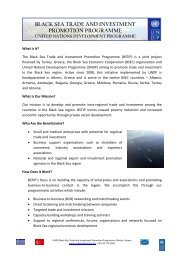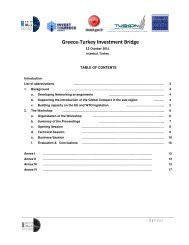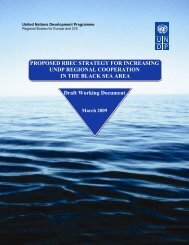Tradeflow Study - UNDP Black Sea Trade and Investment Promotion ...
Tradeflow Study - UNDP Black Sea Trade and Investment Promotion ...
Tradeflow Study - UNDP Black Sea Trade and Investment Promotion ...
You also want an ePaper? Increase the reach of your titles
YUMPU automatically turns print PDFs into web optimized ePapers that Google loves.
Current account balance (% of GDP)<br />
.<br />
Price stability has generally been maintained in the region, although three countries still face<br />
double digit inflation rates: Moldova, Serbia <strong>and</strong> the Russian Federation (13%, 13% <strong>and</strong> 10%<br />
respectively in 2006). Azerbaijan <strong>and</strong> the Ukraine have experienced an 8% increase in their<br />
consumer price index, <strong>and</strong> most other countries in BSEC have low <strong>and</strong> stable inflation.<br />
Figure 1. Basic economic indicators of the BSEC (2005 or latest available year)<br />
15<br />
Scale of bubble indicates the size of the economy (GDP)<br />
10<br />
Russian Federation<br />
US$ 100 billion<br />
5<br />
Ukraine<br />
Serbia <strong>and</strong> Montenegro<br />
US$ 500 billion<br />
0<br />
Azerbaijan<br />
Turkey<br />
- 5<br />
Armenia<br />
Albania<br />
Romania<br />
Greece<br />
- 10<br />
Moldova<br />
Georgia<br />
Bulgaria<br />
- 15<br />
0 5 000 10 000 15 000 20 000<br />
GDP Per capita (US$)<br />
Note: Dashed lines indicate estimated BSEC averages<br />
Source: Estimations from author <strong>and</strong> World Bank World Development Indicators database, 2007<br />
The share of trade in the national economy dropped sharply after the fall of communism but<br />
has since gradually regained prominence <strong>and</strong> in some cases, surpassed pre-market economy<br />
levels. <strong>Trade</strong> flows among countries are in theory a function of the comparative advantages<br />
belonging to these countries <strong>and</strong> the differences in their resources. Bilateral trade between<br />
BSEC countries is highly dependant on historical factors which shaped the complementarily<br />
of their structures of production. A slow diversification process has taken place throughout the<br />
region. The share of trade which is directed to transition economies has declined <strong>and</strong> has<br />
reached between 50 percent in the case of Ukraine to less than 20 percent in the case of<br />
Albania. The relative increase in the share destined to non-transition economies is indicative<br />
of a significant increase in the competitiveness of these economies.<br />
14/135






